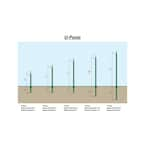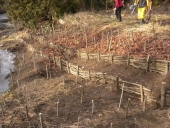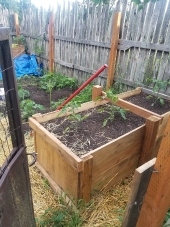I'm posting this in gardening for beginners because I can't think of a better place, but the problem I have is actually that I'm not a beginner anymore, and my original infrastructure is falling apart and needs some repair. I'm looking for some blue-sky thinking by people who have an eye or an imagination for repairs.
I made raised beds with wooden sides when I first started my little plot in the local community gardens about 7 years ago. Here's is a pic from around year 2 so you can see how they are constructed:
Raised bed pic from an old thread
Sides and stakes are green untreated pine from the local sawmill. I'm pleasantly surprised they lasted this long, frankly. Mostly what has happened is:
-- the soil has settled so the top boards are no longer necessary, and
-- the stakes holding up the sides, which you can see are on the inside side of the beds, have been decomposed by our friendly neighborhood decomposing organisms and turned into rich soil, but consequently making the beds start to fall apart.
The side boards are mostly in reusable shape though, I don't think I need to replace many of them.
My plot is on a slope, and I built each bed to be level, so there are spots with 20 cm / 8" of nice soil on top of the ground (previously existing, untouched hard clay + rock + construction rubble)... Whereas near the public walkway on one side, and my downhill neighbor, there might be 60-80 cm (24-30") of soil above ground, standing vertically, just raring to spill all over the place.
So I'm wondering how to repair or otherwise deal with these puppies. Here are some "situations" I'm mulling over:
1) In some places soil pushing at the sides has made them bow out, narrowing the narrow aisles even more, in some places there's not even room to turn around or kneel down to work. That soil is not gonna be easy to move back where it belongs, everything existing gets in the way. I want to push the sides back where they belong, but soil is of course solid and heavy and you can't just push it.
2) Many stakes have rotted through and the sides are loose, flapping around and soil is escaping. It's not a neat edge where I can just push stuff back in place.
3) I feel like I should just take the sides off one at a time and "shave down" the soil to the line where it should be, drive new stakes and reattach the sides, then shovel the excess back on top. But I'm picturing everything collapsing as I try to do this and creating a big disaster. Especially where I border my downhill nieghbor, who has plants growing just inches from the edges of my raised beds.
4) The screws that hold the side boards to the mostly rotten or rotting stakes are difficult/impossible to back out with my drill, if I hammer or rip them out then I may destroy a bunch of otherwise usable side boards which I'll then need to also replace. Creative ideas for gentle screw removal from old weathered wood?
5) The back side of my plot borders a pretty steep embankment. A few stakes have ceded on that side too and sides are bulging out. It's awkward to work on the back side of the bed from the front side, even if that one is only 60cm / 2 ft. or so wide. Don't want to go rolling down that hillside. Can't see doing awkward work from that side on uneven, sloping, slippery terrain. Any bright ideas?
So that's about it. I've used living materials, i.e. wood, and I'm happy about that, and now it's time to replace them as happens with living materials. But I'd love some advice or ideas from people who have a good mind or a knack for doing repairs like thins becasue I am just not finding a general vision of a plan I think will work well.

 1
1




 2
2




 2
2




 1
1





 3
3




 6
6











